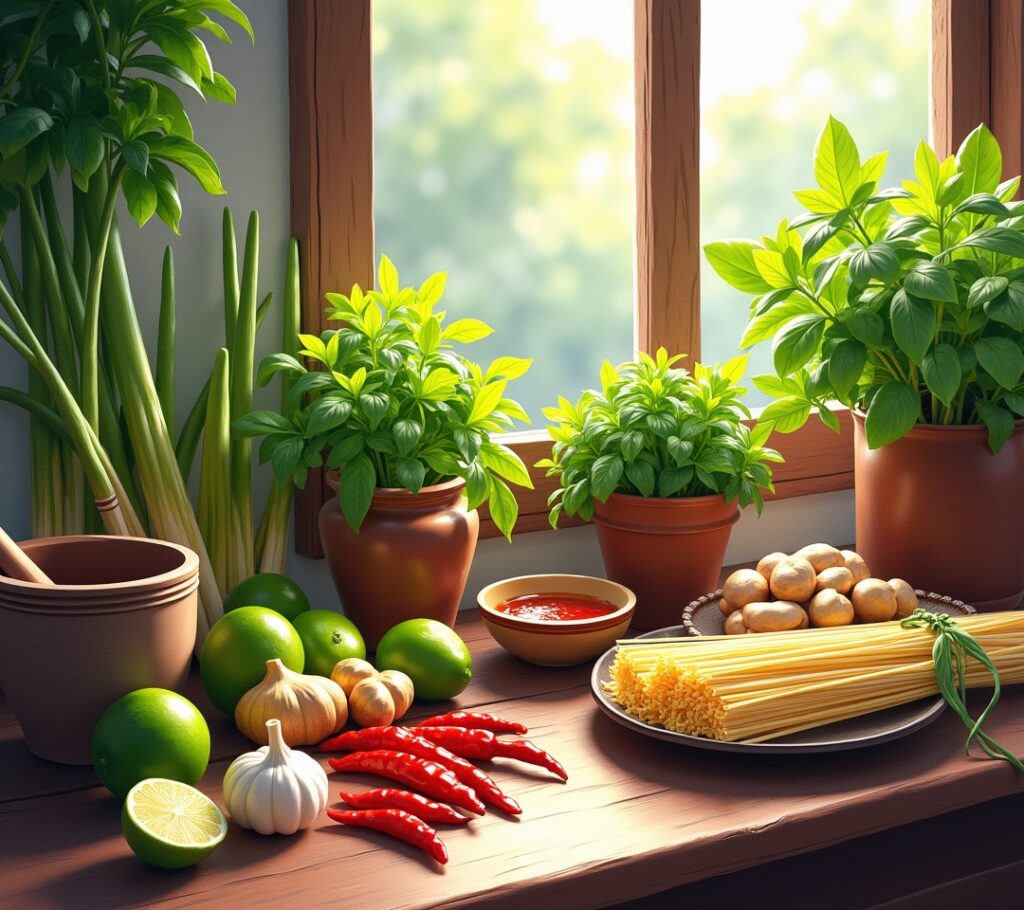Advertisements
Did you know that Vietnamese cuisine ranks among the world’s healthiest cooking styles, with its emphasis on fresh herbs, minimal oil, and balanced flavors? I discovered this firsthand when I moved to a neighborhood with a fantastic Vietnamese market three years ago. What started as curiosity about those mysterious ingredients quickly became my obsession with recreating authentic Vietnamese flavors at home!
Vietnamese home cooking isn’t just about the food—it’s about bringing together simple, fresh ingredients that pack incredible flavor. And trust me, once you start cooking Vietnamese dishes at home, you’ll never want to go back to takeout.
Essential Vietnamese Pantry Staples That Changed My Kitchen Game

Let me tell you about my first Vietnamese grocery shopping trip. I stood there completely overwhelmed, staring at bottles and packages I couldn’t even pronounce. But now? These ingredients are my secret weapons for weeknight dinners that actually taste like something special.
Fish sauce is hands down the most important ingredient you’ll ever buy. I use Red Boat brand religiously—it’s like the soy sauce of Vietnamese cooking but with this incredible umami depth. Start with just a few drops in your stir-fries and watch magic happen.
Rice vinegar became my go-to for everything from salad dressings to marinades. It’s milder than regular vinegar and gives dishes that authentic Vietnamese tang. I probably go through a bottle every two weeks now, which sounds excessive but totally isn’t when you’re making Vietnamese food regularly.
Fresh Herbs and Aromatics: The Heart of Vietnamese Flavors
Here’s where I made my biggest rookie mistake—I thought I could substitute dried herbs for fresh ones. Wrong! Vietnamese cooking is all about that fresh herb game, and there’s simply no shortcut.
Thai basil is completely different from regular basil—it’s got this anise-like flavor that’s absolutely essential for pho and other Vietnamese dishes. I grow it in pots on my windowsill now because buying it fresh every week got expensive fast.
Cilantro and mint are obviously crucial, but here’s a pro tip: buy the whole plants with roots when possible. They last way longer than those sad plastic containers. And lemongrass? Don’t even think about using the dried stuff—fresh lemongrass stalks are where the real flavor lives.
Rice Paper and Noodle Varieties That Actually Matter
I used to think rice paper was just rice paper. Boy, was I wrong about that one! There are different thicknesses and textures, and using the wrong one can totally mess up your spring rolls.
For fresh spring rolls, you want the thin, almost translucent rice papers. The thicker ones are better for fried rolls. I learned this the hard way when my first batch of fresh rolls turned into a gummy mess because I grabbed the wrong package.
Rice noodles are another game-changer for home cooking. Fresh rice noodles are incredible when you can find them, but dried ones work perfectly fine for most dishes. I keep both rice vermicelli and wider rice noodles stocked because they cook so quickly for busy weeknights.
Coconut Products and Tamarind: The Flavor Enhancers
Coconut milk isn’t just for curries—it’s essential for so many Vietnamese dishes. I always keep both full-fat and light coconut milk on hand. The full-fat version is perfect for rich curries, while the lighter one works great for soups and marinades.
Tamarind paste was intimidating at first, but it’s actually super easy to use. It gives dishes this incredible sweet-sour flavor that you just can’t replicate with anything else. I add it to everything from dipping sauces to braised dishes now.
Building Your Vietnamese Spice Cabinet
Vietnamese five-spice is different from Chinese five-spice—it’s more complex and aromatic. I use it in marinades for grilled meats and it makes such a difference. Star anise is another must-have, especially if you’re planning to make pho broth at home.
Don’t forget about shallot oil and garlic oil either. These aren’t exactly spices, but they’re flavor enhancers that Vietnamese cooks use constantly. I make big batches and store them in the fridge for quick flavor boosts.
Your Vietnamese Cooking Adventure Starts Here
Building a Vietnamese pantry takes time, but it’s so worth it. Start with the basics—fish sauce, rice vinegar, and some fresh herbs—then gradually add more ingredients as you get comfortable. Remember, Vietnamese cooking is about balance and freshness, not complicated techniques.
Don’t worry if your first attempts aren’t perfect. I definitely had some disasters along the way! The key is to taste as you go and adjust seasonings to your preference.
Ready to explore more Asian cooking adventures? Head over to Linkcheese for more detailed recipes and cooking tips that’ll help you master these incredible flavors at home!



Pingback: My Strategy for Authentic Vietnamese Food Content